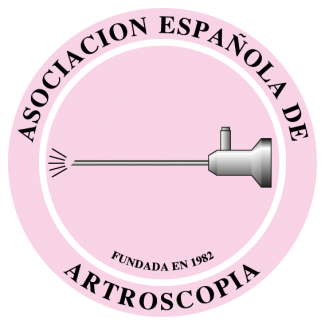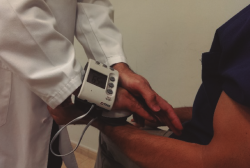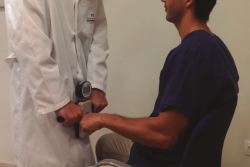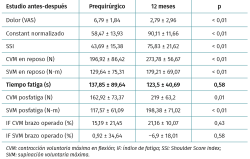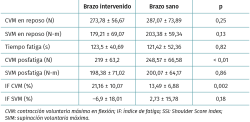Resumen
Objetivo: analizar la fatiga del bíceps braquial tras la realización de tenodesis de su porción larga, parámetro biomecánico importante para conocer la funcionalidad del bíceps tras la intervención.
Material: se ha realizado un estudio prospectivo analizando la fatiga del bíceps en una cohorte de 18 pacientes donde se ha realizado tenodesis de la porción larga del bíceps. El análisis biomecánico y clínico se ha realizado en el preoperatorio, a los 3, 6 y 12 meses de la intervención, incluyendo el tiempo de fatiga, la flexión máxima de codo y supinación de antebrazo, entre otras.
Resultados: se ha demostrado una ausencia de diferencias en el tiempo de fatiga del bíceps tenodesado (123,5 ± 40,69 s) al comparar el resultado con respecto al brazo sano (121,42 ± 52,36 s; p = 0,86) y al preoperatorio (137,85 ± 89,64 s; p = 0,58). Se ha apreciado un incremento de la fuerza de flexión prefatiga del codo intervenido con respecto al preoperatorio (196,92 ± 86,42 N a 273,78 ± 56,67 N; p < 0,01), alcanzando los valores del brazo sano (287,07 ± 73,89 N; p = 0,25). La fuerza de flexión posfatiga ha mejorado con respecto al preoperatorio (162,92 ± 73,37 N a 219 ± 63,2 N; p = 0,01), sin alcanzar los valores del brazo sano (248,57 ± 66,58 N; p < 0,01). La fuerza de supinación del antebrazo ha mejorado con respecto al preoperatorio, alcanzando los valores del brazo sano.
Conclusiones: el hallazgo más importante en el presente estudio es la ausencia de diferencias en el tiempo de fatiga del bíceps (tiempo hasta la claudicación) entre el brazo intervenido mediante tenodesis de la porción larga del bíceps (PLB) con respecto al brazo sano y también con respecto al mismo brazo antes de la intervención. Estas conclusiones tienen su trascendencia en la práctica clínica en la toma de decisiones sobre la actuación en la PLB.
Nivel de evidencia: III.
Abstract
Objective: to analyze the fatigue of the biceps brachii after performing tenodesis of its long portion, an important biomechanical parameter to know the functionality of the biceps after the surgery.
Material: a prospective study was carried out analyzing biceps fatigue in a cohort of 18 patients where tenodesis of the LHBT was performed. A biomechanical and clinical analysis was performed preoperatively, three, six and twelve months after the surgery, including fatigue time, elbow flexion and forearm supination, among others.
Results: it has been demonstrated an absence of differences in fatigue time of the biceps (123.5±40.69 s) when comparing the result with respect to the healthy arm (121.42 ± 52.36 s, p = .86) and preoperative values (137.85 ± 89.64 s, p = .58). An increase in the flexion force of the elbow before fatigue was observed respectly preoperative values (196.92 ± 86.42 N and 273.78 ± 56.67 N, p < .01), reaching the values of the healthy arm (287.07 ± 73.89 N, p = .25). After fatigue flexion strength improved respectly preoperative values (162.92 ± 73.37 N to 219 ± 63.2 N, p = .01), without reaching healthy arm values (248.57 ± 66.58 N; p < .01). Supination force of the forearm has improved with respectly preoperative values, reaching the values of the healthy arm.
Conclusions: the most important finding in the present study is the absence of differences in biceps fatigue time (time to claudication) between the arm operated by tenodesis of the LHBT with respect to the healthy arm and also with respect to the same arm before the surgery. These conclusions have their transcendence in clinical practice in the decision-making about the surgery of the LHBT.
Level of evidence: III.
Artículo
Figuras y tablas
Referencias
Descargas
Licencia
Este contenido es de acceso abierto (Open-Access) y se ha distribuido bajo los términos de la licencia Creative Commons CC BY-NC-ND (Reconocimiento-NoComercial-SinObraDerivada 4.0 Internacional) que permite usar, distribuir y reproducir en cualquier medio siempre que se citen a los autores y no se utilice para fines comerciales ni para hacer obras derivadas.
